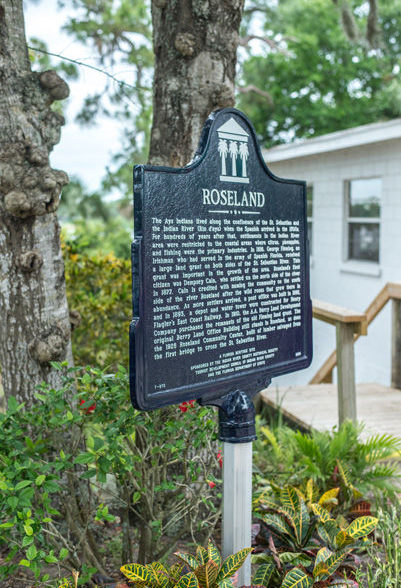
ROSELAND — After years of work by a handful of determined individuals, the little community of Roseland, snuggled along the banks of the St. Sebastian River, has received its own Florida Heritage Site designation.
Located at the Roseland Community Center building on Bay Street (historic in itself ), the designation marker was officially dedicated in a ceremony last month, before a gathering of dignitaries, members of the Roseland Community Association and other area residents.
To visit old Roseland today is to take a step back in time: some structures remain from the early 1900s, and, even now, along the sandy, unpaved streets in the quiet, older neighborhoods, there is a peaceful vibe from another, long-ago era.
Jackie James, a Roseland resident, dedicated supporter of the little community and its unique history and a former president of the Roseland Community Association, has long led the push for the historic designation.
Excited that it is, at long last, a reality, she says, “It took us a long, long time to get it, like 10 years. Our Roseland folks went before the County Commission then and asked to be referred to our then County Historic Advisory Board, which no longer exists. That was the beginning of us asking for an historic designation, as we are such a very old settlement.”
To obtain the coveted designation is no easy task: approval must be given by the Florida Department of State’s Bureau of Historic Preservation, a process which, says Indian River County Historian Ruth Stanbridge, is far more complicated and time-consuming than most could imagine.
Stanbridge is a small, charming woman with an unparalleled knowledge of the county’s unique and fascinating history. And when it comes to preserving and protecting the County’s historical aspects, she’s utterly fearless in dealing with the “alphabet agencies,” all of whom have learned she doesn’t take “No” for an answer.
Stanbridge, representing the Indian River County Historical Society, worked with James and other members of the Roseland Community Association to gather and assemble the information required by the Bureau of Historic Preservation.
Most people, she says, are unaware of how challenging and time consuming the process is, involving far more than simply sending in a request and getting a marker.
Before a request is submitted, extensive research on the “resource” must be done so that a solid case can be made for its worthiness.
The “resource,” in this case, is the community of Roseland. Required information includes a description of the historic and current condition of the resource; a chronological overview of its place in the overall history of the area through the years; and numerous reference documents, maps and photographs.
All must be included in the application package, which is then submitted to the Bureau of Historic Preservation in Tallahassee.
There, a review board consisting of a preservation architect, an FSU history professor and an archeologist conduct a conference call with representatives of the entity submitting the application to discuss the proposal and to decide whether an official historical marker will be approved.
One of the most challenging requirements, Stanbridge remembers, was the text for the marker itself.
“This was where the rubber meets the road!” Within 19 lines, and 1,235 characters (including spaces), the entire history of the “resource” must be clearly presented so that all readers, including those who know nothing about the area, will get a basic understanding of its historical significance.
On the day of the official Roseland request, Stanbridge recalls, she and two other applicants were to make their cases. Because the Board only meets quarterly, should a request be denied, the applicant must wait another three months.
The Board spent 45 minutes with the first applicant alone, who had apparently used the marker text, incorrectly, as an ad for the “resource” as it is today.
Finally, Stanbridge got her chance: Not unexpectedly, the Roseland application was approved quickly.
That done, the text was sent by the Bureau to a studio in Ohio where the markers are made.
They are blue and white, brushed aluminum, 30 inches high by 42 inches wide, on a 6-foot pole. The County’s Historical Markers are funded through grants from the Tourist Development Council of Indian River County.
Today, visitors who pause by the shaded site along the river to read the marker will discover, in a 19-line nutshell, a brief and fascinating history of Roseland: The Ays Indians had lived along the confluence of the St. Sebastian and the Indian River (Rio d’ays) for thousands of years when the Spanish arrived in the 1600s.
For hundreds of years after that, settlements in the Indian River area were restricted to the coastal area where citrus groves, pineapples and fishing were the primary industries.
In 1816, George Fleming, an Irishman who had served in the army of Spanish Florida, received a large land grant in lieu of pay. This grant, on both sides of the St. Sebastian River, proved to be important in the development of the St. Sebastian River and Roseland.
The first citizen of present day Roseland was Dempsey Cain, who settled on the north side of the river in 1877.
In 1910, AA Berry Land Development Company purchased the remnants of the old Fleming Grant.
The south side of the St. Sebastian River became the community of Roseland.
In 1892, as more settlers arrived, a post office was built, and, in 1893, Flagler’s Railroad depot and water tower were constructed.
The original AA Berry Land Office building still stands, as does the Roseland Community Center, constructed in 1926 using timber from the first wooden bridge to cross the St. Sebastian.



